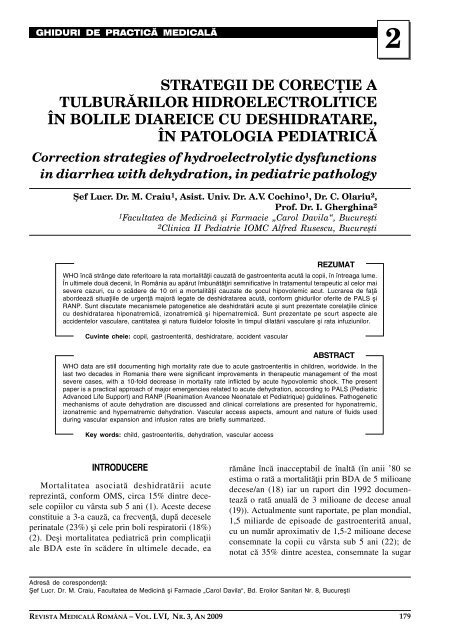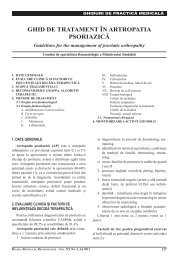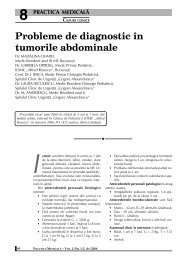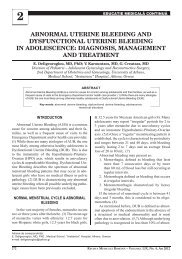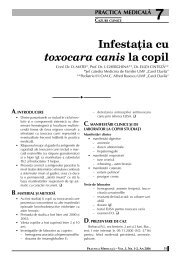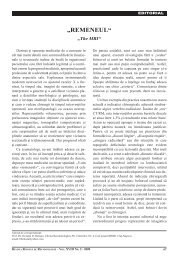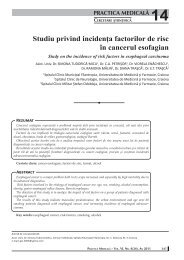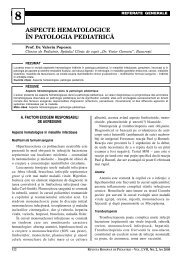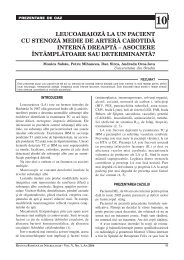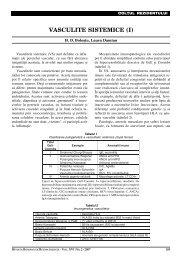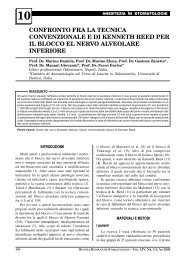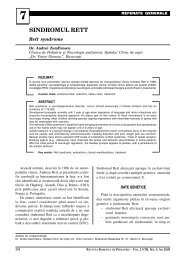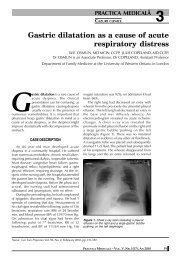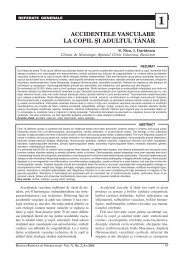strategii de corecºie a tulburårilor hidroelectrolitice în ... - medica.ro
strategii de corecºie a tulburårilor hidroelectrolitice în ... - medica.ro
strategii de corecºie a tulburårilor hidroelectrolitice în ... - medica.ro
Create successful ePaper yourself
Turn your PDF publications into a flip-book with our unique Google optimized e-Paper software.
GHIDURI DE PRACTICÅ MEDICALÅ<br />
STRATEGII DE CORECºIE A<br />
TULBURÅRILOR HIDROELECTROLITICE<br />
ÎN BOLILE DIAREICE CU DESHIDRATARE,<br />
ÎN PATOLOGIA PEDIATRICÅ<br />
Correction strategies of hyd<strong>ro</strong>elect<strong>ro</strong>lytic dysfunctions<br />
in diarrhea with <st<strong>ro</strong>ng>de</st<strong>ro</strong>ng>hydration, in pediatric pathology<br />
ªef Lucr. Dr. M. Craiu 1 , Asist. Univ. Dr. A.V. Cochino 1 , Dr. C. Olariu 2 ,<br />
P<strong>ro</strong>f. Dr. I. Gherghina 2<br />
1 Facultatea <st<strong>ro</strong>ng>de</st<strong>ro</strong>ng> Medicinå ¿i Farmacie „Ca<strong>ro</strong>l Davila“, Bucure¿ti<br />
2 Clinica II Pediatrie IOMC Alfred Rusescu, Bucure¿ti<br />
REZUMAT<br />
WHO <st<strong>ro</strong>ng>în</st<strong>ro</strong>ng>cå strânge date referitoare la rata mortalitå¡ii cauzatå <st<strong>ro</strong>ng>de</st<strong>ro</strong>ng> gast<strong>ro</strong>enterita acutå la copii, <st<strong>ro</strong>ng>în</st<strong>ro</strong>ng> <st<strong>ro</strong>ng>în</st<strong>ro</strong>ng>treaga lume.<br />
În ultimele douå <st<strong>ro</strong>ng>de</st<strong>ro</strong>ng>cenii, <st<strong>ro</strong>ng>în</st<strong>ro</strong>ng> România au apårut îmbunåtå¡iri semnificative <st<strong>ro</strong>ng>în</st<strong>ro</strong>ng> tratamentul terapeutic al celor mai<br />
severe cazuri, cu o scå<st<strong>ro</strong>ng>de</st<strong>ro</strong>ng>re <st<strong>ro</strong>ng>de</st<strong>ro</strong>ng> 10 ori a mortalitå¡ii cauzate <st<strong>ro</strong>ng>de</st<strong>ro</strong>ng> ¿ocul hipovolemic acut. Lucrarea <st<strong>ro</strong>ng>de</st<strong>ro</strong>ng> fa¡å<br />
abor<st<strong>ro</strong>ng>de</st<strong>ro</strong>ng>azå situa¡iile <st<strong>ro</strong>ng>de</st<strong>ro</strong>ng> urgen¡å majorå legate <st<strong>ro</strong>ng>de</st<strong>ro</strong>ng> <st<strong>ro</strong>ng>de</st<strong>ro</strong>ng>shidratarea acutå, conform ghidurilor oferite <st<strong>ro</strong>ng>de</st<strong>ro</strong>ng> PALS ¿i<br />
RANP. Sunt discutate mecanismele patogenetice ale <st<strong>ro</strong>ng>de</st<strong>ro</strong>ng>shidratårii acute ¿i sunt prezentate corela¡iile clinice<br />
cu <st<strong>ro</strong>ng>de</st<strong>ro</strong>ng>shidratarea hiponatremicå, izonatremicå ¿i hipernatremicå. Sunt prezentate pe scurt aspecte ale<br />
acci<st<strong>ro</strong>ng>de</st<strong>ro</strong>ng>ntelor vasculare, cantitatea ¿i natura flui<st<strong>ro</strong>ng>de</st<strong>ro</strong>ng>lor folosite <st<strong>ro</strong>ng>în</st<strong>ro</strong>ng> timpul dilatårii vasculare ¿i rata infuziunilor.<br />
Cuvinte cheie: copil, gast<strong>ro</strong>enteritå, <st<strong>ro</strong>ng>de</st<strong>ro</strong>ng>shidratare, acci<st<strong>ro</strong>ng>de</st<strong>ro</strong>ng>nt vascular<br />
ABSTRACT<br />
WHO data are still documenting high mortality rate due to acute gast<strong>ro</strong>enteritis in children, worldwi<st<strong>ro</strong>ng>de</st<strong>ro</strong>ng>. In the<br />
last two <st<strong>ro</strong>ng>de</st<strong>ro</strong>ng>ca<st<strong>ro</strong>ng>de</st<strong>ro</strong>ng>s in Romania there were significant imp<strong>ro</strong>vements in therapeutic management of the most<br />
severe cases, with a 10-fold <st<strong>ro</strong>ng>de</st<strong>ro</strong>ng>crease in mortality rate inflicted by acute hypovolemic shock. The present<br />
paper is a practical app<strong>ro</strong>ach of major emergencies related to acute <st<strong>ro</strong>ng>de</st<strong>ro</strong>ng>hydration, according to PALS (Pediatric<br />
Advanced Life Support) and RANP (Reanimation Avancee Neonatale et Pediatrique) gui<st<strong>ro</strong>ng>de</st<strong>ro</strong>ng>lines. Pathogenetic<br />
mechanisms of acute <st<strong>ro</strong>ng>de</st<strong>ro</strong>ng>hydration are discussed and clinical correlations are presented for hyponatremic,<br />
izonatremic and hypernatremic <st<strong>ro</strong>ng>de</st<strong>ro</strong>ng>hydration. Vascular access aspects, amount and nature of fluids used<br />
during vascular expansion and infusion rates are briefly summarized.<br />
Key words: child, gast<strong>ro</strong>enteritis, <st<strong>ro</strong>ng>de</st<strong>ro</strong>ng>hydration, vascular access<br />
INTRODUCERE<br />
Mortalitatea asociatå <st<strong>ro</strong>ng>de</st<strong>ro</strong>ng>shidratårii acute<br />
reprezintå, conform OMS, circa 15% dintre <st<strong>ro</strong>ng>de</st<strong>ro</strong>ng>cesele<br />
copiilor cu vârsta sub 5 ani (1). Aceste <st<strong>ro</strong>ng>de</st<strong>ro</strong>ng>cese<br />
constituie a 3-a cauzå, ca frecven¡å, dupå <st<strong>ro</strong>ng>de</st<strong>ro</strong>ng>cesele<br />
perinatale (23%) ¿i cele prin boli respiratorii (18%)<br />
(2). De¿i mortalitatea pediatricå prin complica¡ii<br />
ale BDA este <st<strong>ro</strong>ng>în</st<strong>ro</strong>ng> scå<st<strong>ro</strong>ng>de</st<strong>ro</strong>ng>re <st<strong>ro</strong>ng>în</st<strong>ro</strong>ng> ultimele <st<strong>ro</strong>ng>de</st<strong>ro</strong>ng>ca<st<strong>ro</strong>ng>de</st<strong>ro</strong>ng>, ea<br />
Adreså <st<strong>ro</strong>ng>de</st<strong>ro</strong>ng> corespon<st<strong>ro</strong>ng>de</st<strong>ro</strong>ng>n¡å:<br />
ªef Lucr. Dr. M. Craiu, Facultatea <st<strong>ro</strong>ng>de</st<strong>ro</strong>ng> Medicinå ¿i Farmacie „Ca<strong>ro</strong>l Davila“, Bd. E<strong>ro</strong>ilor Sanitari Nr. 8, Bucure¿ti<br />
REVISTA MEDICALÅ ROMÂNÅ – VOL. LVI, NR. 3, AN 2009 179<br />
2<br />
råmâne <st<strong>ro</strong>ng>în</st<strong>ro</strong>ng>cå inacceptabil <st<strong>ro</strong>ng>de</st<strong>ro</strong>ng> <st<strong>ro</strong>ng>în</st<strong>ro</strong>ng>altå (<st<strong>ro</strong>ng>în</st<strong>ro</strong>ng> anii ’80 se<br />
estima o ratå a mortalitå¡ii prin BDA <st<strong>ro</strong>ng>de</st<strong>ro</strong>ng> 5 milioane<br />
<st<strong>ro</strong>ng>de</st<strong>ro</strong>ng>cese/an (18) iar un raport din 1992 documenteazå<br />
o ratå anualå <st<strong>ro</strong>ng>de</st<strong>ro</strong>ng> 3 milioane <st<strong>ro</strong>ng>de</st<strong>ro</strong>ng> <st<strong>ro</strong>ng>de</st<strong>ro</strong>ng>cese anual<br />
(19)). Actualmente sunt raportate, pe plan mondial,<br />
1,5 miliar<st<strong>ro</strong>ng>de</st<strong>ro</strong>ng> <st<strong>ro</strong>ng>de</st<strong>ro</strong>ng> episoa<st<strong>ro</strong>ng>de</st<strong>ro</strong>ng> <st<strong>ro</strong>ng>de</st<strong>ro</strong>ng> gast<strong>ro</strong>enteritå anual,<br />
cu un numår ap<strong>ro</strong>ximativ <st<strong>ro</strong>ng>de</st<strong>ro</strong>ng> 1,5-2 milioane <st<strong>ro</strong>ng>de</st<strong>ro</strong>ng>cese<br />
consemnate la copii cu vârsta sub 5 ani (22); <st<strong>ro</strong>ng>de</st<strong>ro</strong>ng><br />
notat cå 35% dintre acestea, consemnate la sugar
180 REVISTA MEDICALÅ ROMÂNÅ – VOL. LVI, NR. 3, AN 2009<br />
¿i pre¿colar, sunt p<strong>ro</strong>duse <st<strong>ro</strong>ng>în</st<strong>ro</strong>ng> faza acutå a bolii, <st<strong>ro</strong>ng>în</st<strong>ro</strong>ng><br />
primele ore sau zile <st<strong>ro</strong>ng>de</st<strong>ro</strong>ng> boalå (23).<br />
Valorile mortalitå¡ii sunt <st<strong>ro</strong>ng>de</st<strong>ro</strong>ng>pen<st<strong>ro</strong>ng>de</st<strong>ro</strong>ng>nte <st<strong>ro</strong>ng>de</st<strong>ro</strong>ng> statusul<br />
sociocultural al popula¡iei respective ¿i <st<strong>ro</strong>ng>de</st<strong>ro</strong>ng> nivelul<br />
<st<strong>ro</strong>ng>de</st<strong>ro</strong>ng> <st<strong>ro</strong>ng>de</st<strong>ro</strong>ng>zvoltare al ¡årii analizate (15,16,17). Al¡i factori<br />
incrimina¡i sunt gradul <st<strong>ro</strong>ng>de</st<strong>ro</strong>ng> educa¡ie maternå ¿i<br />
facilitatea accesului la serviciile <st<strong>ro</strong>ng>medica</st<strong>ro</strong>ng>le (22).<br />
Primele eforturi structurate pentru combaterea<br />
<st<strong>ro</strong>ng>de</st<strong>ro</strong>ng>shidratårii severe au vizat tratamentul <st<strong>ro</strong>ng>în</st<strong>ro</strong>ng> holerå<br />
¿i au fost publicate <st<strong>ro</strong>ng>în</st<strong>ro</strong>ng> Lancet <st<strong>ro</strong>ng>în</st<strong>ro</strong>ng> 1832 (24).<br />
În România, <st<strong>ro</strong>ng>de</st<strong>ro</strong>ng>¿i a avut loc o reducere semnificativå<br />
a <st<strong>ro</strong>ng>de</st<strong>ro</strong>ng>ceselor prin diaree <st<strong>ro</strong>ng>în</st<strong>ro</strong>ng> ultimele douå<br />
<st<strong>ro</strong>ng>de</st<strong>ro</strong>ng>ca<st<strong>ro</strong>ng>de</st<strong>ro</strong>ng>, <st<strong>ro</strong>ng>în</st<strong>ro</strong>ng>cå se mai <st<strong>ro</strong>ng>în</st<strong>ro</strong>ng>registreazå o cifrå importantå.<br />
Într-un studiu personal (3) am putut<br />
estima cå <st<strong>ro</strong>ng>de</st<strong>ro</strong>ng>cesele prin complica¡ii ale gast<strong>ro</strong>enteritelor<br />
reprezentau 39,65% din totalul <st<strong>ro</strong>ng>de</st<strong>ro</strong>ng>ceselor<br />
la pacien¡ii interna¡i <st<strong>ro</strong>ng>în</st<strong>ro</strong>ng> clinicå, la sfâr¿itul<br />
anilor ’80 (dintr-un total <st<strong>ro</strong>ng>de</st<strong>ro</strong>ng> 26,8 <st<strong>ro</strong>ng>de</st<strong>ro</strong>ng>cese/1000 <st<strong>ro</strong>ng>de</st<strong>ro</strong>ng><br />
pacien¡i interna¡i). Aceastå cifrå a scåzut foarte mult<br />
mai ales pe seama diminuårii numårului <st<strong>ro</strong>ng>de</st<strong>ro</strong>ng> <st<strong>ro</strong>ng>de</st<strong>ro</strong>ng>cese<br />
la copiii spitaliza¡i (2,83 <st<strong>ro</strong>ng>de</st<strong>ro</strong>ng>cese/1000 <st<strong>ro</strong>ng>de</st<strong>ro</strong>ng> pacien¡i<br />
interna¡i <st<strong>ro</strong>ng>în</st<strong>ro</strong>ng> ultimii 6 ani <st<strong>ro</strong>ng>în</st<strong>ro</strong>ng> IOMC).<br />
EVALUAREA GRADULUI DE DESHIDRATARE LA<br />
COPIL<br />
Deshidratarea apare prin <st<strong>ro</strong>ng>de</st<strong>ro</strong>ng>zechilibrul balan¡ei<br />
flui<st<strong>ro</strong>ng>de</st<strong>ro</strong>ng>lor din organismul copilului. În mod normal,<br />
<st<strong>ro</strong>ng>în</st<strong>ro</strong>ng> tractul digestiv al unui adult sånåtos sunt<br />
„manipula¡i“ 6,5 litri <st<strong>ro</strong>ng>de</st<strong>ro</strong>ng> flui<st<strong>ro</strong>ng>de</st<strong>ro</strong>ng> pe zi. Ace¿tia<br />
p<strong>ro</strong>vin din aportul oral ¿i din secre¡iile diverselor<br />
structuri ale aparatului digestiv (salivå, suc gastric,<br />
bilå, sucuri intestinale). Volumul sca<st<strong>ro</strong>ng>de</st<strong>ro</strong>ng> la 1,5 litri<br />
ca urmare a p<strong>ro</strong>ceselor <st<strong>ro</strong>ng>de</st<strong>ro</strong>ng> reabsorb¡ie, pânå la nivelul<br />
ileonului terminal ¿i apoi pânå la < 250 ml<br />
fluid eliminat <st<strong>ro</strong>ng>în</st<strong>ro</strong>ng> scaun (25).<br />
Deshidratarea poate fi rezultatul unui aport<br />
insuficient <st<strong>ro</strong>ng>de</st<strong>ro</strong>ng> lichi<st<strong>ro</strong>ng>de</st<strong>ro</strong>ng> sau al unor pier<st<strong>ro</strong>ng>de</st<strong>ro</strong>ng>ri crescute,<br />
pe cale oralå (vårsåturi, perspira¡ie insensibilå),<br />
intestinalå (diaree, sechestrare <st<strong>ro</strong>ng>de</st<strong>ro</strong>ng> flui<st<strong>ro</strong>ng>de</st<strong>ro</strong>ng> <st<strong>ro</strong>ng>în</st<strong>ro</strong>ng>tr-un<br />
intestin paretic), pe cale renalå (poliurie), pe cale<br />
cutanatå (transpira¡ii p<strong>ro</strong>fuze, arsuri) etc. Alte cauze<br />
<st<strong>ro</strong>ng>de</st<strong>ro</strong>ng> balan¡å hidricå negativå sunt <st<strong>ro</strong>ng>în</st<strong>ro</strong>ng>tâlnite <st<strong>ro</strong>ng>în</st<strong>ro</strong>ng> cazurile<br />
cu transport anormal la nivelul diverselor structuri<br />
epiteliale: se<strong>ro</strong>zite (ascitå, revårsat pleural sau<br />
pericardic), e<st<strong>ro</strong>ng>de</st<strong>ro</strong>ng>m intersti¡ial prin leziuni endoteliale<br />
(la pacien¡i cu sepsis sau cu intoxica¡ii severe).<br />
Deshidratårile acute pot fi clasificate dupå<br />
gradul <st<strong>ro</strong>ng>de</st<strong>ro</strong>ng> severitate sau dupå impactul acestora<br />
asupra osmolaritå¡ii. Astfel, din punct <st<strong>ro</strong>ng>de</st<strong>ro</strong>ng> ve<st<strong>ro</strong>ng>de</st<strong>ro</strong>ng>re<br />
Tabel 1. Clasificarea diareilor dupå severitate – dupå Stone B. (4)<br />
practic, putem <st<strong>ro</strong>ng>în</st<strong>ro</strong>ng>tâlni <st<strong>ro</strong>ng>de</st<strong>ro</strong>ng>shidratåri u¿oare, medii<br />
sau severe (vezi tabelul 1) sau <st<strong>ro</strong>ng>de</st<strong>ro</strong>ng>shidratåri cu<br />
osmolaritate micå, normalå sau crescutå. Folosind<br />
natremia ca o valoare orientativå pentru osmolaritate<br />
(presupunând cå nivelurile glicemice sunt<br />
normale putem ap<strong>ro</strong>xima nivelurile natremiei ca<br />
având o variabilitate similarå cu cea a osmolaritå¡ii)<br />
vom <st<strong>ro</strong>ng>în</st<strong>ro</strong>ng>tâlni <st<strong>ro</strong>ng>de</st<strong>ro</strong>ng>shidratåri hiponatremice, izonatremice<br />
¿i hipernatremice.<br />
Deshidratårile hiper-, hipo- sau izonatremice<br />
pot îmbråca diferite gra<st<strong>ro</strong>ng>de</st<strong>ro</strong>ng> <st<strong>ro</strong>ng>de</st<strong>ro</strong>ng> severitate. La acela¿i<br />
grad <st<strong>ro</strong>ng>de</st<strong>ro</strong>ng> severitate al <st<strong>ro</strong>ng>de</st<strong>ro</strong>ng>shidratårii simptomatologia<br />
este variabilå <st<strong>ro</strong>ng>în</st<strong>ro</strong>ng> func¡ie <st<strong>ro</strong>ng>de</st<strong>ro</strong>ng> tipul <st<strong>ro</strong>ng>de</st<strong>ro</strong>ng>shidratårii,<br />
având expresie clinicå total diferitå la <st<strong>ro</strong>ng>de</st<strong>ro</strong>ng>shidratårile<br />
cu hiponatremie severå fa¡å <st<strong>ro</strong>ng>de</st<strong>ro</strong>ng> cele cu hipernatremie<br />
importantå.<br />
În <st<strong>ro</strong>ng>de</st<strong>ro</strong>ng>shidratårile izonatremice, natremia are<br />
varia¡ii <st<strong>ro</strong>ng>în</st<strong>ro</strong>ng>tre 130-150 mEq/L, <st<strong>ro</strong>ng>în</st<strong>ro</strong>ng> cele hiponatremice<br />
valorile natremiei sunt sub 130 mEq/L<br />
iar <st<strong>ro</strong>ng>în</st<strong>ro</strong>ng> cele hipernatremice peste 150 mEq/L.<br />
Deshidratårile izonatremice reprezintå circa 80%<br />
din totalul <st<strong>ro</strong>ng>de</st<strong>ro</strong>ng>shidratårilor la copil, celelalte tipuri<br />
apårând <st<strong>ro</strong>ng>în</st<strong>ro</strong>ng> p<strong>ro</strong>por¡ii ap<strong>ro</strong>ximativ egale, cu varia¡ii<br />
<st<strong>ro</strong>ng>în</st<strong>ro</strong>ng>tre 5-10% dintre cazurile citate <st<strong>ro</strong>ng>în</st<strong>ro</strong>ng> literaturå.<br />
Tipul <st<strong>ro</strong>ng>de</st<strong>ro</strong>ng> <st<strong>ro</strong>ng>de</st<strong>ro</strong>ng>shidratare este <st<strong>ro</strong>ng>de</st<strong>ro</strong>ng>pen<st<strong>ro</strong>ng>de</st<strong>ro</strong>ng>nt <st<strong>ro</strong>ng>de</st<strong>ro</strong>ng> natura<br />
flui<st<strong>ro</strong>ng>de</st<strong>ro</strong>ng>lor pierdute <st<strong>ro</strong>ng>în</st<strong>ro</strong>ng> cadrul p<strong>ro</strong>cesului patologic. O<br />
pier<st<strong>ro</strong>ng>de</st<strong>ro</strong>ng>re rapidå <st<strong>ro</strong>ng>de</st<strong>ro</strong>ng> flui<st<strong>ro</strong>ng>de</st<strong>ro</strong>ng> izotone, cu o cantitate<br />
p<strong>ro</strong>por¡ionalå <st<strong>ro</strong>ng>de</st<strong>ro</strong>ng> apå ¿i elect<strong>ro</strong>li¡i, va <st<strong>ro</strong>ng>de</st<strong>ro</strong>ng>termina o<br />
<st<strong>ro</strong>ng>de</st<strong>ro</strong>ng>shidratare izotonå, cu impact similar asupra<br />
spa¡iului lichidian intra- ¿i extravascular. În cazul<br />
<st<strong>ro</strong>ng>de</st<strong>ro</strong>ng>shidratårilor hiponatremice se pier<st<strong>ro</strong>ng>de</st<strong>ro</strong>ng> o cantitate<br />
relativ mai mare <st<strong>ro</strong>ng>de</st<strong>ro</strong>ng> sodiu comparativ cu pier<st<strong>ro</strong>ng>de</st<strong>ro</strong>ng>rea<br />
<st<strong>ro</strong>ng>de</st<strong>ro</strong>ng> apå, astfel <st<strong>ro</strong>ng>în</st<strong>ro</strong>ng>cât apare hiponatremie la nivelul<br />
flui<st<strong>ro</strong>ng>de</st<strong>ro</strong>ng>lor circulante. Din cauza hipotoniei acestor<br />
flui<st<strong>ro</strong>ng>de</st<strong>ro</strong>ng> circulante, apa va avea tendin¡a <st<strong>ro</strong>ng>de</st<strong>ro</strong>ng> a trece <st<strong>ro</strong>ng>în</st<strong>ro</strong>ng><br />
mod pasiv cåtre spa¡iul extravascular, agravând<br />
hipovolemia existentå. În cazul <st<strong>ro</strong>ng>de</st<strong>ro</strong>ng>shidratårilor hipernatremice,<br />
apare un fenomen invers, cu pier<st<strong>ro</strong>ng>de</st<strong>ro</strong>ng>rea<br />
unei cantitå¡i relativ mai mari <st<strong>ro</strong>ng>de</st<strong>ro</strong>ng> apå, comparativ cu<br />
pier<st<strong>ro</strong>ng>de</st<strong>ro</strong>ng>rea <st<strong>ro</strong>ng>de</st<strong>ro</strong>ng> sodiu, astfel <st<strong>ro</strong>ng>în</st<strong>ro</strong>ng>cât apare hipernatremie.<br />
Din aceastå cauzå, apa va avea tendin¡a <st<strong>ro</strong>ng>de</st<strong>ro</strong>ng> a trece<br />
<st<strong>ro</strong>ng>în</st<strong>ro</strong>ng> mod pasiv cåtre spa¡iul intravascular, temporizând<br />
apari¡ia semnelor clinice <st<strong>ro</strong>ng>de</st<strong>ro</strong>ng> colaps circulator.<br />
Cunoa¿terea tipului <st<strong>ro</strong>ng>de</st<strong>ro</strong>ng> <st<strong>ro</strong>ng>de</st<strong>ro</strong>ng>shidratare este esen-<br />
¡ialå pentru a putea minimaliza riscurile asociate<br />
reexpansionårii volemice.<br />
În situa¡iile cu hiponatremie, <st<strong>ro</strong>ng>de</st<strong>ro</strong>ng>seori asociate<br />
cu semne grave <st<strong>ro</strong>ng>de</st<strong>ro</strong>ng> suferin¡å neu<strong>ro</strong>logicå (convulsii<br />
recurente), dacå se p<strong>ro</strong>duce o corec¡ie prea<br />
rapidå a <st<strong>ro</strong>ng>de</st<strong>ro</strong>ng>ficitului <st<strong>ro</strong>ng>de</st<strong>ro</strong>ng> sodiu (mai rapid <st<strong>ro</strong>ng>de</st<strong>ro</strong>ng>cât 2
REVISTA MEDICALÅ ROMÂNÅ – VOL. LVI, NR. 3, AN 2009<br />
mEq/L/orå) vor apårea sechele neu<strong>ro</strong>logice pe termen<br />
lung, ca urmare a mielinolizei pontine (5). Viteza i<st<strong>ro</strong>ng>de</st<strong>ro</strong>ng>alå<br />
<st<strong>ro</strong>ng>de</st<strong>ro</strong>ng> corec¡ie a unei <st<strong>ro</strong>ng>de</st<strong>ro</strong>ng>shidratåri hiponatremice severe<br />
este <st<strong>ro</strong>ng>de</st<strong>ro</strong>ng> ap<strong>ro</strong>ximativ 10 mEq/L/24 ore (6).<br />
În situa¡iile cu hipernatremie apare un p<strong>ro</strong>ces<br />
pasiv <st<strong>ro</strong>ng>de</st<strong>ro</strong>ng> transport al apei intracelulare cåtre intersti¡iu<br />
¿i cåtre spa¡iul intravascular. Råspunsul<br />
celular la acest „furt“ activ <st<strong>ro</strong>ng>de</st<strong>ro</strong>ng> apå este sinteza unor<br />
molecule osmotic active (osmoli idiogenici) ce au<br />
tendin¡a <st<strong>ro</strong>ng>de</st<strong>ro</strong>ng>-a echilibra balan¡a <st<strong>ro</strong>ng>de</st<strong>ro</strong>ng> flui<st<strong>ro</strong>ng>de</st<strong>ro</strong>ng>, neutralizând<br />
efluxul masiv <st<strong>ro</strong>ng>de</st<strong>ro</strong>ng> apå din celulå. Un<br />
exemplu similar, ca mecanism <st<strong>ro</strong>ng>de</st<strong>ro</strong>ng> compensare a<br />
stårii <st<strong>ro</strong>ng>de</st<strong>ro</strong>ng> hipe<strong>ro</strong>smolaritate, este consemnat <st<strong>ro</strong>ng>în</st<strong>ro</strong>ng> cazul<br />
sintezei <st<strong>ro</strong>ng>de</st<strong>ro</strong>ng> osmoli cerebrali la pacien¡ii cu <st<strong>ro</strong>ng>de</st<strong>ro</strong>ng>shidratare<br />
severå <st<strong>ro</strong>ng>în</st<strong>ro</strong>ng> cadrul comei diabetice hipe<strong>ro</strong>smolare<br />
(7). Dacå acest tip <st<strong>ro</strong>ng>de</st<strong>ro</strong>ng> mecanism compensator<br />
este ignorat ¿i se realizeazå o expansionare<br />
volemicå rapidå, va apårea e<st<strong>ro</strong>ng>de</st<strong>ro</strong>ng>m cerebral<br />
cu risc letal. Pentru a scå<st<strong>ro</strong>ng>de</st<strong>ro</strong>ng>a riscul acestui tip <st<strong>ro</strong>ng>de</st<strong>ro</strong>ng><br />
complica¡ie este necesarå o corec¡ie lentå a <st<strong>ro</strong>ng>de</st<strong>ro</strong>ng>shidratårii<br />
hipernatremice, pe durata a 48 <st<strong>ro</strong>ng>de</st<strong>ro</strong>ng> ore (8).<br />
Uneori, când nu ¿tim greutatea anterioarå episodului<br />
acut sau <st<strong>ro</strong>ng>în</st<strong>ro</strong>ng> acele cazuri <st<strong>ro</strong>ng>în</st<strong>ro</strong>ng> care nu putem<br />
måsura natremia <st<strong>ro</strong>ng>în</st<strong>ro</strong>ng> timp util, se poate face evaluarea<br />
severitå¡ii gradului <st<strong>ro</strong>ng>de</st<strong>ro</strong>ng> <st<strong>ro</strong>ng>de</st<strong>ro</strong>ng>shidratare pe baza<br />
unor criterii clinice (vezi tabelul 2). În general,<br />
pacien¡ii cu <st<strong>ro</strong>ng>de</st<strong>ro</strong>ng>shidratare izo- sau hipertonå aratå<br />
clinic „mai råu“ <st<strong>ro</strong>ng>de</st<strong>ro</strong>ng>cât cei cu o <st<strong>ro</strong>ng>de</st<strong>ro</strong>ng>shidratare hiponatremicå<br />
echivalentå ca magnitudine. Semnele<br />
clasice <st<strong>ro</strong>ng>de</st<strong>ro</strong>ng> <st<strong>ro</strong>ng>de</st<strong>ro</strong>ng>shidratare, cu afectarea pliului cutanat,<br />
a turgorului, a umiditå¡ii diverselor mucoase,<br />
sunt <st<strong>ro</strong>ng>de</st<strong>ro</strong>ng> intensitate mult mai mare la sugarii cu natremie<br />
normalå sau crescutå (vezi fig. 1).<br />
De mare gravitate sunt unele semne clinice care<br />
sunt relativ rar <st<strong>ro</strong>ng>în</st<strong>ro</strong>ng>tâlnite la ora actualå: <st<strong>ro</strong>ng>de</st<strong>ro</strong>ng>primarea<br />
fontanelei anterioare ¿i <st<strong>ro</strong>ng>în</st<strong>ro</strong>ng>cålecarea suturilor cra-<br />
181<br />
niene la sugar (vezi fig. 2.) ¿i prezen¡a pliului cutanat<br />
persistent (apect <st<strong>ro</strong>ng>de</st<strong>ro</strong>ng> cârpå umedå „stoarså“)<br />
(vezi fig. 3)<br />
Figura 1. Sugar cu <st<strong>ro</strong>ng>de</st<strong>ro</strong>ng>shidratare izonatremicå severå.<br />
Se remarcå aspectul <st<strong>ro</strong>ng>de</st<strong>ro</strong>ng> mucoase uscate (buze<br />
„pråjite“) ¿i enoftalmia (ochii „<st<strong>ro</strong>ng>în</st<strong>ro</strong>ng>cercåna¡i“).<br />
PRINCIPII DE CORECºIE A TULBURÅRILOR<br />
HIDRO-ELECTROLITICE ÎN GASTROENTERITE<br />
Acest articol dore¿te så abor<st<strong>ro</strong>ng>de</st<strong>ro</strong>ng>ze doar principiile<br />
terapeutice ale rehidratårii copilului cu gast<strong>ro</strong>enteritå<br />
Figura 2. Sugar cu <st<strong>ro</strong>ng>de</st<strong>ro</strong>ng>shidratare izonatremicå severå.<br />
Se remarcå aspectul <st<strong>ro</strong>ng>de</st<strong>ro</strong>ng> <st<strong>ro</strong>ng>de</st<strong>ro</strong>ng>primare marcatå a<br />
fontanelei anterioare (fontanela anterioarå „<st<strong>ro</strong>ng>în</st<strong>ro</strong>ng>fundatå“)<br />
¿i enoftalmia (ochii „<st<strong>ro</strong>ng>în</st<strong>ro</strong>ng>cercåna¡i“).<br />
Tabelul 2. Evaluarea gradului <st<strong>ro</strong>ng>de</st<strong>ro</strong>ng> <st<strong>ro</strong>ng>de</st<strong>ro</strong>ng>shidratere acutå folosind criterii clinice –<br />
adaptat dupå Steiner MJ (9)<br />
SEMN/SIMPTOM SDA UŞOARĂ SDA MEDIE SDA SEVERĂ<br />
Stare <st<strong>ro</strong>ng>de</st<strong>ro</strong>ng> conştienţă Treaz Letargic Comatos<br />
TRC* 2 - 3 secun<st<strong>ro</strong>ng>de</st<strong>ro</strong>ng> 3-4 secun<st<strong>ro</strong>ng>de</st<strong>ro</strong>ng> >4, extremităţi reci<br />
Mucoase normale Uscate „Prăjite“, fisurate<br />
Lacrimi prezente Reduse absente<br />
AV** Normală/uşor Crescută Foarte<br />
crescută<br />
crescută/scăzută<br />
FR* Normală Crescută Foarte<br />
crescută/polipnee<br />
TA* Normală Normală Scăzută<br />
Puls Normal Slab palpabil Foarte slab/absent<br />
Pliu cutanat Normal Leneş Persistent<br />
Fontanelă Normală Discret<br />
<st<strong>ro</strong>ng>de</st<strong>ro</strong>ng>primată<br />
Sever <st<strong>ro</strong>ng>de</st<strong>ro</strong>ng>primată<br />
Ochi Normali Încercănaţi Înfundaţi <st<strong>ro</strong>ng>în</st<strong>ro</strong>ng> orbite<br />
Diureză Normală Oligurie Oligurie/anurie<br />
* TRC – timp <st<strong>ro</strong>ng>de</st<strong>ro</strong>ng> reumplere capilarå; ** AV – alurå ventricularå; *** FR – frecven¡å respiratorie;<br />
**** TA – tensiune arterialå
182 REVISTA MEDICALÅ ROMÂNÅ – VOL. LVI, NR. 3, AN 2009<br />
Figura 3. Sugar cu <st<strong>ro</strong>ng>de</st<strong>ro</strong>ng>shidratare izonatremicå severå.<br />
Se remarcå aspectul <st<strong>ro</strong>ng>de</st<strong>ro</strong>ng> pliu cutanat abdominal<br />
persistent.<br />
acutå ¿i se va referi doar la combaterea <st<strong>ro</strong>ng>tulburårilor</st<strong>ro</strong>ng><br />
hid<strong>ro</strong>-elect<strong>ro</strong>litice. Nu vor fi discutate aspecte <st<strong>ro</strong>ng>de</st<strong>ro</strong>ng><br />
dieteticå pediaticå ¿i nici elemente privind sind<strong>ro</strong>amele<br />
post-enteritice (intoleran¡å secundarå la<br />
lactozå, sind<strong>ro</strong>amele <st<strong>ro</strong>ng>de</st<strong>ro</strong>ng> malabsorb¡ie, tulburårile<br />
<st<strong>ro</strong>ng>de</st<strong>ro</strong>ng> cre¿tere ¿i <st<strong>ro</strong>ng>de</st<strong>ro</strong>ng>zvoltare secundare).<br />
Principiul major ce trebuie så guverneze resuscitarea<br />
volemicå a oricårui copil, indiferent <st<strong>ro</strong>ng>de</st<strong>ro</strong>ng><br />
gradul <st<strong>ro</strong>ng>de</st<strong>ro</strong>ng> severitate al acesteia, este men¡inerea<br />
unui pat vascular plin, euvolemia fiind ¡inta terapeuticå<br />
centralå. Nimic nu este mai important <st<strong>ro</strong>ng>de</st<strong>ro</strong>ng>cât<br />
refacerea volumului <st<strong>ro</strong>ng>de</st<strong>ro</strong>ng> sânge circulant normal!<br />
Dezechilibrele ionice trebuie corectate ulterior,<br />
<st<strong>ro</strong>ng>de</st<strong>ro</strong>ng> cele mai multe ori ob¡inerea unei homeostazii<br />
elect<strong>ro</strong>litice putând fi atinså la 24-48 ore <st<strong>ro</strong>ng>de</st<strong>ro</strong>ng> la<br />
ini¡ierea terapiei. O corec¡ie mai rapidå nu este<br />
recomandatå, aceasta putând fi chiar periculoaså,<br />
cu sechele pe termen lung (6,8).<br />
Pentru formele u¿oare <st<strong>ro</strong>ng>de</st<strong>ro</strong>ng> <st<strong>ro</strong>ng>de</st<strong>ro</strong>ng>shidratare ar fi<br />
i<st<strong>ro</strong>ng>de</st<strong>ro</strong>ng>alå rehidratarea pe cale oralå, chiar la acei pacien¡i<br />
care prezintå ¿i vårsåturi (29). Eficien¡a rehidratårii<br />
orale nu este inferioarå celei pe cale<br />
parenteralå, chiar ¿i la copii cu <st<strong>ro</strong>ng>de</st<strong>ro</strong>ng>shidratåri <st<strong>ro</strong>ng>de</st<strong>ro</strong>ng> intensitate<br />
medie, 90% dintre ace¿tia putând fi rehidrata¡i<br />
pe cale oralå (29,32).<br />
Solu¡iile <st<strong>ro</strong>ng>de</st<strong>ro</strong>ng> rehidratare oralå reprezintå p<strong>ro</strong>babil<br />
cea mai mare <st<strong>ro</strong>ng>de</st<strong>ro</strong>ng>soperire <st<strong>ro</strong>ng>medica</st<strong>ro</strong>ng>lå, alåturi <st<strong>ro</strong>ng>de</st<strong>ro</strong>ng> antibiotice,<br />
<st<strong>ro</strong>ng>în</st<strong>ro</strong>ng> secolul XX. Numårul <st<strong>ro</strong>ng>de</st<strong>ro</strong>ng> bolnavi având<br />
afec¡iuni extrem <st<strong>ro</strong>ng>de</st<strong>ro</strong>ng> grave, poten¡ial letale, ¿i care<br />
au supravie¡uit ca urmare a folosirii solu¡iilor <st<strong>ro</strong>ng>de</st<strong>ro</strong>ng><br />
rehidratare, este enorm. Primele studii care au<br />
dovedit folosirea eficientå a SRO (solu¡ii <st<strong>ro</strong>ng>de</st<strong>ro</strong>ng> rehidratare<br />
oralå) au fost publicate <st<strong>ro</strong>ng>în</st<strong>ro</strong>ng> anii ’60-’70, <st<strong>ro</strong>ng>în</st<strong>ro</strong>ng><br />
cursul ultimei mari epiemii <st<strong>ro</strong>ng>de</st<strong>ro</strong>ng> holerå (26,27,28).<br />
Eficacitatea SRO a impus inclu<st<strong>ro</strong>ng>de</st<strong>ro</strong>ng>rea acestora <st<strong>ro</strong>ng>în</st<strong>ro</strong>ng><br />
toate ghiduile <st<strong>ro</strong>ng>de</st<strong>ro</strong>ng> practicå ce vizau tratamentul<br />
gast<strong>ro</strong>enteritelor (ale OMS, ale Aca<st<strong>ro</strong>ng>de</st<strong>ro</strong>ng>miei Americane<br />
<st<strong>ro</strong>ng>de</st<strong>ro</strong>ng> Pediatrie AAP, ale Societå¡ii Eu<strong>ro</strong>pene<br />
<st<strong>ro</strong>ng>de</st<strong>ro</strong>ng> gast<strong>ro</strong>ente<strong>ro</strong>logie ¿i Hepatologie Pediatricå<br />
ESPAGHAN)(29,30,31).<br />
Folosirea SRO este utilå ¿i la copii cu diaree<br />
fårå <st<strong>ro</strong>ng>de</st<strong>ro</strong>ng>shidratare evi<st<strong>ro</strong>ng>de</st<strong>ro</strong>ng>ntå, la ace¿tia fiind folosit<br />
fluidul pentru a combate pier<st<strong>ro</strong>ng>de</st<strong>ro</strong>ng>rile lichidiene ulterioare<br />
<st<strong>ro</strong>ng>în</st<strong>ro</strong>ng>ceperii terapiei. Vor fi administra¡i 10 ml/<br />
kg/scaun emis (29).<br />
Tehnica rehidratårii orale cu SRO la pacien¡ii<br />
cu vårsåturi este relativ laborioaså, durând foarte<br />
mult timp ¿i punând la grea <st<strong>ro</strong>ng>în</st<strong>ro</strong>ng>cercare råbdarea<br />
celui care o realizeazå. Ea poate fi utilizatå la domiciliu<br />
sau la acei pacien¡i la care familia este<br />
instruitå ¿i cooperantå, participand activ la manevre:<br />
la fiecare 1-2 minute sunt administra¡i câte<br />
5 ml SRO (o linguri¡å). Astfel ar putea fi dat un<br />
volum <st<strong>ro</strong>ng>de</st<strong>ro</strong>ng> 150-300 ml/orå (30). Tot la acest grup<br />
<st<strong>ro</strong>ng>de</st<strong>ro</strong>ng> pacien¡i (cu vårsåturi) unii autori recomandå<br />
administrarea flui<st<strong>ro</strong>ng>de</st<strong>ro</strong>ng>lor pe calea unei son<st<strong>ro</strong>ng>de</st<strong>ro</strong>ng> nazogastrice<br />
(NG) (30), <st<strong>ro</strong>ng>de</st<strong>ro</strong>ng>¿i aspectul este foarte cont<strong>ro</strong>versat.<br />
Nu existå un cont<strong>ro</strong>l bun al umplerii<br />
gastrice ¿i nici al presiunii intragastrice, dacå flui<st<strong>ro</strong>ng>de</st<strong>ro</strong>ng>le<br />
sunt administrate cu seringa. Pentru a diminua<br />
riscurile asociate manevrei <st<strong>ro</strong>ng>de</st<strong>ro</strong>ng> rehidratare pe calea<br />
unei son<st<strong>ro</strong>ng>de</st<strong>ro</strong>ng> NG, ar putea fi utilizatå tehnica <st<strong>ro</strong>ng>de</st<strong>ro</strong>ng><br />
gavaj gravita¡ional, adicå flui<st<strong>ro</strong>ng>de</st<strong>ro</strong>ng>le vor fi turnate<br />
<st<strong>ro</strong>ng>în</st<strong>ro</strong>ng>tr-o seringå fårå piston, ata¿atå la sonda NG.<br />
Flui<st<strong>ro</strong>ng>de</st<strong>ro</strong>ng>le vor intra lent <st<strong>ro</strong>ng>în</st<strong>ro</strong>ng> stomac, <st<strong>ro</strong>ng>în</st<strong>ro</strong>ng> concordan¡å<br />
cu presiunea intragastricå (30). La pacien¡ii comato¿i<br />
sau la cei cu ileus tehnica gavajului pe<br />
sonda NG este contraindicatå.<br />
La copiii cu diaree ¿i <st<strong>ro</strong>ng>de</st<strong>ro</strong>ng>shidratare u¿oarå se<br />
vor administra 50 ml/kg SRO <st<strong>ro</strong>ng>în</st<strong>ro</strong>ng> 3-4 ore, la ace¿tia<br />
fiind adåugat fluidul din pier<st<strong>ro</strong>ng>de</st<strong>ro</strong>ng>rile lichidiene<br />
ulterioare (ongoing fluid-loss) <st<strong>ro</strong>ng>în</st<strong>ro</strong>ng>ceperii terapiei.<br />
Vor fi administra¡i <st<strong>ro</strong>ng>în</st<strong>ro</strong>ng> plus 10 ml/kg/scaun emis<br />
(29). Cel mai rar va fi reevaluat pacientul la 2 ore<br />
interval, pentru a putea calcula „ongoing fluidloss“.<br />
La copiii cu <st<strong>ro</strong>ng>de</st<strong>ro</strong>ng>shidratare medie se vor<br />
administra 100 ml/kg SRO <st<strong>ro</strong>ng>în</st<strong>ro</strong>ng> 3-4 ore, la ace¿tia<br />
fiind adåugat fluidul din pier<st<strong>ro</strong>ng>de</st<strong>ro</strong>ng>rile lichidiene ulterioare<br />
(29).<br />
Pentru a putea realiza expansionarea <st<strong>ro</strong>ng>în</st<strong>ro</strong>ng> timp<br />
util a patului vascular la pacien¡ii afla¡i <st<strong>ro</strong>ng>în</st<strong>ro</strong>ng> situa¡ie<br />
criticå este necesarå ob¡inerea unei cåi <st<strong>ro</strong>ng>de</st<strong>ro</strong>ng> acces<br />
vascular <st<strong>ro</strong>ng>de</st<strong>ro</strong>ng> bunå calitate.<br />
Tentativele <st<strong>ro</strong>ng>de</st<strong>ro</strong>ng> ob¡inere a unei cåi <st<strong>ro</strong>ng>de</st<strong>ro</strong>ng> acces pe<br />
calea unei vene periferice ar trebui limitate la trei<br />
<st<strong>ro</strong>ng>în</st<strong>ro</strong>ng>cercåri sau la maximum 90 <st<strong>ro</strong>ng>de</st<strong>ro</strong>ng> secun<st<strong>ro</strong>ng>de</st<strong>ro</strong>ng>, la pacien¡ii<br />
afla¡i <st<strong>ro</strong>ng>în</st<strong>ro</strong>ng> situa¡ie criticå (10). Orice prelungire<br />
a duratei <st<strong>ro</strong>ng>în</st<strong>ro</strong>ng> care se ob¡ine accesul vascular comp<strong>ro</strong>mite<br />
¿ansele <st<strong>ro</strong>ng>de</st<strong>ro</strong>ng> resuscitare volemicå reu¿itå.<br />
Dacå <st<strong>ro</strong>ng>în</st<strong>ro</strong>ng> intervalul <st<strong>ro</strong>ng>de</st<strong>ro</strong>ng> 90 <st<strong>ro</strong>ng>de</st<strong>ro</strong>ng> secun<st<strong>ro</strong>ng>de</st<strong>ro</strong>ng> nu se ob¡ine<br />
acces vascular ¿i pacientul se aflå <st<strong>ro</strong>ng>în</st<strong>ro</strong>ng> ¿oc <st<strong>ro</strong>ng>de</st<strong>ro</strong>ng>compensat<br />
(semne clinice <st<strong>ro</strong>ng>de</st<strong>ro</strong>ng> hipoperfuzie perifericå<br />
¿i tensiune arterialå scåzutå) se va <st<strong>ro</strong>ng>în</st<strong>ro</strong>ng>cerca ob¡inerea<br />
unui acces vascular pe cale intraosoaså (IO).<br />
Acesta este indicat <st<strong>ro</strong>ng>în</st<strong>ro</strong>ng> primul rând la pacien¡ii afla¡i
REVISTA MEDICALÅ ROMÂNÅ – VOL. LVI, NR. 3, AN 2009<br />
<st<strong>ro</strong>ng>în</st<strong>ro</strong>ng> stare criticå, atunci când abordarea ini¡ialå<br />
i<st<strong>ro</strong>ng>de</st<strong>ro</strong>ng>ntificå un pacient aflat <st<strong>ro</strong>ng>în</st<strong>ro</strong>ng> stop cardiorespirator.<br />
Abordul IO are 83% ¿anse <st<strong>ro</strong>ng>de</st<strong>ro</strong>ng> reu¿itå, prin compara¡ie<br />
cu numai 17% <st<strong>ro</strong>ng>în</st<strong>ro</strong>ng> cazul tentativelor <st<strong>ro</strong>ng>de</st<strong>ro</strong>ng> acces<br />
vascular cu ajutorul unei branule, tentative efectuate<br />
la nivelul unei vene periferice, la un copil<br />
aflat <st<strong>ro</strong>ng>în</st<strong>ro</strong>ng> stop cardiorespirator (11).<br />
Dupå ob¡inerea unei cåi <st<strong>ro</strong>ng>de</st<strong>ro</strong>ng> acces eficiente, pacientului<br />
cu semne <st<strong>ro</strong>ng>de</st<strong>ro</strong>ng> ¿oc i se vor administra solu¡ii<br />
<st<strong>ro</strong>ng>de</st<strong>ro</strong>ng> cristaloizi pe cale intravenoaså. Solu¡iile <st<strong>ro</strong>ng>de</st<strong>ro</strong>ng><br />
elec¡ie pentru umplerea patului vascular, la un<br />
pacient cu hipovolemie, sunt serul fiziologic – SF<br />
(NaCl solu¡ie 0,9%) sau solu¡ia <st<strong>ro</strong>ng>de</st<strong>ro</strong>ng> Ringer lactat –<br />
RL. Nu se vor administra <st<strong>ro</strong>ng>în</st<strong>ro</strong>ng> scopul umplerii patului<br />
vascular solu¡ii glucozate, indiferent <st<strong>ro</strong>ng>de</st<strong>ro</strong>ng> nivelul<br />
glicemiei sau <st<strong>ro</strong>ng>de</st<strong>ro</strong>ng> concentra¡ia acestor solu¡ii!<br />
Volumul <st<strong>ro</strong>ng>de</st<strong>ro</strong>ng> fluid folosit pentru corec¡ia rapidå<br />
a volemiei este <st<strong>ro</strong>ng>de</st<strong>ro</strong>ng> 20 ml/kg. Aceastå cantitate <st<strong>ro</strong>ng>de</st<strong>ro</strong>ng><br />
solu¡ie <st<strong>ro</strong>ng>de</st<strong>ro</strong>ng> SF sau RL, numitå „bolus“ <st<strong>ro</strong>ng>în</st<strong>ro</strong>ng> literatura<br />
<st<strong>ro</strong>ng>medica</st<strong>ro</strong>ng>lå anglo-saxonå, va fi administratå cât mai<br />
rapid, cu ajutorul unui injectomat sau direct cu<br />
ajutorul unei seringi (12). Durata maximå <st<strong>ro</strong>ng>de</st<strong>ro</strong>ng> timp<br />
<st<strong>ro</strong>ng>în</st<strong>ro</strong>ng> care este imperios necesar så administråm<br />
bolusul este o orå (30). Pier<st<strong>ro</strong>ng>de</st<strong>ro</strong>ng>rea <st<strong>ro</strong>ng>de</st<strong>ro</strong>ng> flui<st<strong>ro</strong>ng>de</st<strong>ro</strong>ng> ar putea<br />
så nu fie compensatå doar prin administrarea unui<br />
singur bolus <st<strong>ro</strong>ng>de</st<strong>ro</strong>ng> flui<st<strong>ro</strong>ng>de</st<strong>ro</strong>ng>, motiv pentru care este,<br />
<st<strong>ro</strong>ng>de</st<strong>ro</strong>ng>seori, necesarå repetarea manevrei. Dacå administrarea<br />
unui al doilea bolus nu restabile¿te<br />
volemia ¿i se men¡in semnele <st<strong>ro</strong>ng>de</st<strong>ro</strong>ng> <st<strong>ro</strong>ng>de</st<strong>ro</strong>ng>shidratare<br />
severå, va fi necesarå administrarea unui coloid,<br />
<st<strong>ro</strong>ng>în</st<strong>ro</strong>ng> speran¡a cå acesta va avea o remanen¡å crescutå<br />
<st<strong>ro</strong>ng>în</st<strong>ro</strong>ng> spa¡iul intravascular, ob¡inându-se refacerea volemiei<br />
circulante. Pot fi folosite solu¡ii <st<strong>ro</strong>ng>de</st<strong>ro</strong>ng> albuminå<br />
5%, <st<strong>ro</strong>ng>de</st<strong>ro</strong>ng>xtran sau oligomeri <st<strong>ro</strong>ng>de</st<strong>ro</strong>ng> glucozå, <st<strong>ro</strong>ng>în</st<strong>ro</strong>ng> cantitate<br />
<st<strong>ro</strong>ng>de</st<strong>ro</strong>ng> 10 ml/kg.<br />
Volumul <st<strong>ro</strong>ng>de</st<strong>ro</strong>ng> flui<st<strong>ro</strong>ng>de</st<strong>ro</strong>ng> ¿i cantitatea <st<strong>ro</strong>ng>de</st<strong>ro</strong>ng> elect<strong>ro</strong>li¡i<br />
pierdu¡i <st<strong>ro</strong>ng>în</st<strong>ro</strong>ng> cursul unei <st<strong>ro</strong>ng>de</st<strong>ro</strong>ng>shidratåri acute severe<br />
sunt <st<strong>ro</strong>ng>de</st<strong>ro</strong>ng>pen<st<strong>ro</strong>ng>de</st<strong>ro</strong>ng>nte <st<strong>ro</strong>ng>de</st<strong>ro</strong>ng> mecanismele generatoare ale<br />
acestor pier<st<strong>ro</strong>ng>de</st<strong>ro</strong>ng>ri, variind consi<st<strong>ro</strong>ng>de</st<strong>ro</strong>ng>rabil <st<strong>ro</strong>ng>în</st<strong>ro</strong>ng> func¡ie <st<strong>ro</strong>ng>de</st<strong>ro</strong>ng><br />
cauzå – vezi tabelul 3.<br />
Pentru a putea calcula <st<strong>ro</strong>ng>de</st<strong>ro</strong>ng>ficitele <st<strong>ro</strong>ng>de</st<strong>ro</strong>ng> apå ¿i elect<strong>ro</strong>li¡i,<br />
<st<strong>ro</strong>ng>în</st<strong>ro</strong>ng> cazul unei <st<strong>ro</strong>ng>de</st<strong>ro</strong>ng>shidratåri severe, este necesar<br />
så cunoa¿tem compozi¡ia normalå a flui<st<strong>ro</strong>ng>de</st<strong>ro</strong>ng>lor<br />
183<br />
intracelulare ¿i extracelulare, respectiv coeficien¡ii<br />
<st<strong>ro</strong>ng>de</st<strong>ro</strong>ng> distribu¡ie ai principalilor elect<strong>ro</strong>li¡i – vezi tabelele<br />
4 ¿i 5.<br />
De obicei se folose¿te formula:<br />
mEq necesari = (CD – CP) x fD x G<br />
CD reprezintå concentra¡ia doritå a fi atinså <st<strong>ro</strong>ng>în</st<strong>ro</strong>ng><br />
urma corec¡iei, CP reprezintå concentra¡ia plasmaticå<br />
actualå, anterioarå corec¡iei, fD este factorul <st<strong>ro</strong>ng>de</st<strong>ro</strong>ng><br />
distribu¡ie (vezi tabelul 4) iar G este greutatea copilului<br />
anterioarå îmbolnåvirii, exprimatå <st<strong>ro</strong>ng>în</st<strong>ro</strong>ng> kilograme.<br />
Tabelul 4. Factorul <st<strong>ro</strong>ng>de</st<strong>ro</strong>ng> distribu¡ie folosit <st<strong>ro</strong>ng>în</st<strong>ro</strong>ng> calculul<br />
<st<strong>ro</strong>ng>de</st<strong>ro</strong>ng>ficitelor <st<strong>ro</strong>ng>de</st<strong>ro</strong>ng> elect<strong>ro</strong>li¡i – dupå Stone B (4).<br />
Tabelul 5. Compozi¡ia flui<st<strong>ro</strong>ng>de</st<strong>ro</strong>ng>lor corporeale (intra- ¿i<br />
extracelulare) – dupå Stone B (4).<br />
INTRACELULAR EXTRACELULAR<br />
(mEq/L)<br />
(mEq/L)<br />
SODIU 20 133-145<br />
POTASIU 150 3-5<br />
CLOR – 98-110<br />
BICARBONAT 10 20-25<br />
FOSFAT 110-115 5<br />
PROTEINE 75 10<br />
Unii autori includ <st<strong>ro</strong>ng>în</st<strong>ro</strong>ng> abordarea terapeuticå<br />
ini¡ialå a copilului cu BDA ¿i <st<strong>ro</strong>ng>medica</st<strong>ro</strong>ng>mentele ce<br />
modificå motilitatea gast<strong>ro</strong>-intestinalå (29,30).<br />
Conform consensului grupului <st<strong>ro</strong>ng>de</st<strong>ro</strong>ng> exper¡i ai Aca<st<strong>ro</strong>ng>de</st<strong>ro</strong>ng>miei<br />
Americane <st<strong>ro</strong>ng>de</st<strong>ro</strong>ng> Pediatrie (AAP) nu ar trebui<br />
folosite <st<strong>ro</strong>ng>medica</st<strong>ro</strong>ng>mente cu ac¡iune antiperistalticå la<br />
copilul mic, <st<strong>ro</strong>ng>de</st<strong>ro</strong>ng>oarece riscurile <st<strong>ro</strong>ng>de</st<strong>ro</strong>ng>på¿esc poten-<br />
¡ialele beneficii. Astfel, AAP nu recomandå folosirea<br />
<st<strong>ro</strong>ng>de</st<strong>ro</strong>ng> rutinå a loperamidului, opioizilor ¿i <st<strong>ro</strong>ng>de</st<strong>ro</strong>ng>rivatelor<br />
acestora, anticolinergicelor, absorbantelor<br />
sau a bismutului salicilic (30).<br />
AFECºIUNE APÅ (ml/kg) Na + (mEq/kg) K + (mEq/kg) Cl- Tabelul 3. Pier<st<strong>ro</strong>ng>de</st<strong>ro</strong>ng>rile <st<strong>ro</strong>ng>de</st<strong>ro</strong>ng> apå ¿i elect<strong>ro</strong>li¡i, <st<strong>ro</strong>ng>în</st<strong>ro</strong>ng> func¡ie <st<strong>ro</strong>ng>de</st<strong>ro</strong>ng> cauzå – dupå Hellerstein S<br />
(13)<br />
(mEq/kg)<br />
BDA cu SDA<br />
hiponatremicå<br />
100-120 10-15 8-15 10-12<br />
BDA cu SDA<br />
izotonicå<br />
100-120 8-10 8-10 8-10<br />
BDA cu SDA<br />
hipernatremicå<br />
100-120 2-4 0-6 0-3<br />
Stenozå<br />
piloricå<br />
100-120 8-10 10-12 10-12<br />
Cetoacidozå<br />
diabeticå<br />
100 8 6-10 6
184 REVISTA MEDICALÅ ROMÂNÅ – VOL. LVI, NR. 3, AN 2009<br />
CONTROVERSE<br />
Analiza documentelor <st<strong>ro</strong>ng>medica</st<strong>ro</strong>ng>le ale pacien¡ilor<br />
cu gast<strong>ro</strong>enteritå severå transfera¡i <st<strong>ro</strong>ng>în</st<strong>ro</strong>ng> IOMC aratå<br />
faptul cå <st<strong>ro</strong>ng>de</st<strong>ro</strong>ng> obicei <st<strong>ro</strong>ng>în</st<strong>ro</strong>ng> România, ace¿tia primesc,<br />
<st<strong>ro</strong>ng>în</st<strong>ro</strong>ng> cursul abordårii ini¡iale cu antibiotice, corticoste<strong>ro</strong>izi<br />
¿i bicarbonat.<br />
Acestå abordare practicå ar trebui så disparå<br />
treptat, <st<strong>ro</strong>ng>de</st<strong>ro</strong>ng>oarece nu existå dovezi <st<strong>ro</strong>ng>în</st<strong>ro</strong>ng> sprijinul ei.<br />
În anumite circumstan¡e, o astfel <st<strong>ro</strong>ng>de</st<strong>ro</strong>ng> tentativå terapeuticå<br />
poate avea efecte catast<strong>ro</strong>fale asupra<br />
pacientului, putând genera complica¡ii amenin¡åtoare<br />
<st<strong>ro</strong>ng>de</st<strong>ro</strong>ng> via¡å sau chiar <st<strong>ro</strong>ng>de</st<strong>ro</strong>ng>ces. Astfel, administrarea<br />
ira¡ionalå <st<strong>ro</strong>ng>de</st<strong>ro</strong>ng> antibiotice, la to¡i pacien¡ii<br />
cu BDA afla¡i <st<strong>ro</strong>ng>în</st<strong>ro</strong>ng> situa¡ie gravå ar putea precipita<br />
apari¡ia unui sind<strong>ro</strong>m Gasser (sind<strong>ro</strong>m hemoliticuremic),<br />
prin eliberarea masivå <st<strong>ro</strong>ng>de</st<strong>ro</strong>ng> endotoxine (14).<br />
Antibioterapia nu constituie o urgen¡å majorå <st<strong>ro</strong>ng>în</st<strong>ro</strong>ng><br />
BDA ¿i ar trebui rezervatå pacien¡ilor cu gast<strong>ro</strong>enterite<br />
suspectate pe criterii clinice (scaune cu<br />
mucus, pu<strong>ro</strong>i sau sânge, la un pacient febril, cu<br />
aspect general „toxic“) sau dovedite ca fiind bacteriene<br />
(prin cop<strong>ro</strong>culturå ¿i cop<strong>ro</strong>citogramå).<br />
Administrarea <st<strong>ro</strong>ng>de</st<strong>ro</strong>ng> bicarbonat <st<strong>ro</strong>ng>de</st<strong>ro</strong>ng> sodiu, fårå documentarea<br />
unei acidoze metabolice, refractarå la<br />
expansionarea volemicå eficace ar putea p<strong>ro</strong>duce<br />
complica¡ii cu risc letal (prin hipercapnie, hipernatremie,<br />
hipe<strong>ro</strong>smolaritate).<br />
BIBLIOGRAFIE<br />
1. Murray CJL, Lopez AD – The global bur<st<strong>ro</strong>ng>de</st<strong>ro</strong>ng>n of disease: a<br />
comprehensive assessment of mortality and disability f<strong>ro</strong>m diseases,<br />
injury and risk factors <st<strong>ro</strong>ng>în</st<strong>ro</strong>ng> 1990 and p<strong>ro</strong>jected to 2020 Geneva, WHO,<br />
1996<br />
2. *** - The World’s Forgotten Children. <st<strong>ro</strong>ng>în</st<strong>ro</strong>ng> site-ul http://www.who.int/<br />
ceh/publications/01mortality.pdf, accesat 12.03.2009<br />
3. Craiu M, Iordåchescu M, Cochino AV, Avram P, Anca AI –<br />
Intraosseous infussion, valulable tool for pediatric resuscitation. <st<strong>ro</strong>ng>în</st<strong>ro</strong>ng><br />
site-ul http://www.kenes.com/espid2008/, (26 th Eu<strong>ro</strong>pean Society of<br />
Pediatric Infectious Diseases Annual Meeting, Graz, 2008), accesat<br />
<st<strong>ro</strong>ng>în</st<strong>ro</strong>ng> 10.03.2009.<br />
4. Stone B – Fluids and Elect<strong>ro</strong>lytes <st<strong>ro</strong>ng>în</st<strong>ro</strong>ng> The Harriet Lane Handbook.<br />
Editors Robertson J, Shilokofski N, 17 th edition, 2005, Ed Elsevier<br />
Mosby, pag 285<br />
5. Gocht A, Colmant HJ – Central pontine and extrapontine<br />
myelinolysis: a report of 58 cases. Clin. Neu<strong>ro</strong>pathol. 1987;6 (6):<br />
262–70.<br />
6. Kleinschmidt-DeMasters BK, Norenberg MD – Rapid correction<br />
of hyponatremia causes <st<strong>ro</strong>ng>de</st<strong>ro</strong>ng>myelination: relation to central pontine<br />
myelinolysis. Science. 1981;211(4486):1068-70.<br />
7. Chiasson JL, Aris-Jilwan N, Belanger R, et al – Diagnosis and<br />
treatment of diabetic ketoacidosis and the hyperglycemic<br />
hype<strong>ro</strong>smolar state. CMAJ 2003;168(7):859-66.<br />
8. Gottschalk ME, Ros SP, Zeller WP – The emergency<br />
management of hyperglycemic-hype<strong>ro</strong>smolar nonketotic coma in the<br />
pediatric patient. Pediatr Emerg Care. 1996;12(1):48-51.<br />
În concluzie, la pacien¡ii cu <st<strong>ro</strong>ng>de</st<strong>ro</strong>ng>shidratare severå<br />
ar trebui urma¡i o serie <st<strong>ro</strong>ng>de</st<strong>ro</strong>ng> pa¿i bine <st<strong>ro</strong>ng>de</st<strong>ro</strong>ng>fini¡i, <st<strong>ro</strong>ng>în</st<strong>ro</strong>ng><br />
func¡ie <st<strong>ro</strong>ng>de</st<strong>ro</strong>ng> natura <st<strong>ro</strong>ng>de</st<strong>ro</strong>ng>shidratårii ¿i <st<strong>ro</strong>ng>de</st<strong>ro</strong>ng> vârsta ¿i comorbiditå¡ile<br />
pacientului.<br />
MESAJ PRACTIC<br />
1. Primul obiectiv al tratamentului la pacien¡ii<br />
cu BDA ¿i <st<strong>ro</strong>ng>de</st<strong>ro</strong>ng>shidratare severå este refacerea<br />
volemiei.<br />
2. Normalizarea volemiei poate fi realizatå pe<br />
cale oralå cu SRO sau pe cale intravenoaså<br />
cu solu¡ii <st<strong>ro</strong>ng>de</st<strong>ro</strong>ng> cristaloizi, <st<strong>ro</strong>ng>în</st<strong>ro</strong>ng> func¡ie <st<strong>ro</strong>ng>de</st<strong>ro</strong>ng> gravitatea<br />
<st<strong>ro</strong>ng>de</st<strong>ro</strong>ng>shidratårii, <st<strong>ro</strong>ng>de</st<strong>ro</strong>ng> toleran¡a digestivå<br />
a copilului ¿i <st<strong>ro</strong>ng>de</st<strong>ro</strong>ng> starea <st<strong>ro</strong>ng>de</st<strong>ro</strong>ng> con¿tien¡å a acestuia.<br />
3. Nu vor fi folosite solu¡iile <st<strong>ro</strong>ng>de</st<strong>ro</strong>ng> glucozå (indiferent<br />
<st<strong>ro</strong>ng>de</st<strong>ro</strong>ng> concentra¡ia lor!) pentru refacerea<br />
volemiei. La pacien¡ii cu hipoglicemie,<br />
aceasta va fi corectatå ulterior refacerii volemiei,<br />
pe o altå cale venoaså.<br />
4. Folosirea antibioticelor ¿i a bicarbonatului<br />
<st<strong>ro</strong>ng>de</st<strong>ro</strong>ng> sodiu ar trebui rezervatå unor cazuri speciale,<br />
<st<strong>ro</strong>ng>în</st<strong>ro</strong>ng> majoritatea ente<strong>ro</strong>colitelor acute ele<br />
fiind contraindicate.<br />
9. Steiner MJ, DeWalt DA, Byerley JS – Is this child <st<strong>ro</strong>ng>de</st<strong>ro</strong>ng>hydrated?<br />
JAMA. 2004;291(22):2746-54.<br />
10. Biarent D, Bingham R et al – Eu<strong>ro</strong>pean Resuscitation Council<br />
Gui<st<strong>ro</strong>ng>de</st<strong>ro</strong>ng>lines for Resuscitation 2005. Section 6. Paediatric Life<br />
Support. Resuscitation 2005; 67S1:S97-S133.<br />
11. LaRocco BG, Wang HE – Intraosseous Infussion. Prehosp Emerg<br />
Care 2003;7(2): 3-14<br />
12. *** - American Heart Association Gui<st<strong>ro</strong>ng>de</st<strong>ro</strong>ng>lines for Cardiopulmonary<br />
Resuscitation and Emergency Cardiovascular Care. Part 11. Pediatric<br />
Basic Life Support. Circulation. 2005; 112: IV 156 – IV 166.<br />
13. Hellerstein S – Fluids and elect<strong>ro</strong>lytes: clinical aspects. Pediatr Rev<br />
1993; 14(3):103-115.<br />
14. Ahn CK, Holt NJ, Tarr PI – Shiga-toxin p<strong>ro</strong>ducing Escherichia coli<br />
and the hemolytic uremic synd<strong>ro</strong>me: what have we learned <st<strong>ro</strong>ng>în</st<strong>ro</strong>ng> the<br />
past 25 years? Adv Exp Med Biol. 2009;634:1-17.<br />
15. Kosek M, Bern C, Guerrant RL – The global bur<st<strong>ro</strong>ng>de</st<strong>ro</strong>ng>n of diarrhoeal<br />
disease, as estimated f<strong>ro</strong>m studies published between 1992 and<br />
2000. Bull World Health Organ 2003;81:197—204.<br />
16. Parashar U, Hummelman E, Bresee J, Miller M, Glass R –<br />
Global Illness and <st<strong>ro</strong>ng>de</st<strong>ro</strong>ng>aths caused by <strong>ro</strong>tavirus disease in children.<br />
Emerg Infect Dis 2003;9:565-572.<br />
17. Black RE, Morris SS, Bryce J. Where and why are 10 million<br />
children dying every year? Lancet 2003;361:2226-2234.<br />
18. Sny<st<strong>ro</strong>ng>de</st<strong>ro</strong>ng>r JD, Merson MH – The magnitu<st<strong>ro</strong>ng>de</st<strong>ro</strong>ng> of the global p<strong>ro</strong>blem of<br />
acute diarrhoeal disease: a review of active surveillance data. Bull<br />
World Health Organ 1982;60:605-613.
REVISTA MEDICALÅ ROMÂNÅ – VOL. LVI, NR. 3, AN 2009<br />
19. Bern C, Martines J, <st<strong>ro</strong>ng>de</st<strong>ro</strong>ng> Zoysa I, Glass RI – The magnitu<st<strong>ro</strong>ng>de</st<strong>ro</strong>ng> of<br />
the global p<strong>ro</strong>blem of diarrhoeal disease: a ten year update. Bull<br />
World Health Organ 1992;70:705-714.<br />
20. Sny<st<strong>ro</strong>ng>de</st<strong>ro</strong>ng>r JD – Use and misuse of oral therapy for diarrhea:<br />
comparison of US practices with American Aca<st<strong>ro</strong>ng>de</st<strong>ro</strong>ng>my of Pediatrics<br />
recommendations. Pediatrics 1991;87:28-33.<br />
21. Reis EC, Goepp JG, Katz S, Santosham M – Barriers to use of<br />
oral rehydration therapy. Pediatrics 1994;93:708-711.<br />
22. King KC, Glass R, Bresee JS, Duggan C – Managing acute<br />
gast<strong>ro</strong>enteritis among children. MMWR 2003; 52(RR16):1-16.<br />
23. Patel A et al – Zinc Supplementation May Not Be Effective for<br />
Acute Diarrhea <st<strong>ro</strong>ng>în</st<strong>ro</strong>ng> Children. BMC Medicine. 5 May 2009<br />
24. Latta T – Malignant cholera: documents communicated by the<br />
Central Board of Health London, relative to the treatment of cholera<br />
by copious injection of aqueous and saline fluids into the veins.<br />
Lancet 1832;2:274.<br />
25. Acra SA, Ghishan GK – Elect<strong>ro</strong>lyte fluxes in the gut and oral<br />
rehydration solutions. Pediatr Clin North Am 1996;43:433-449.<br />
26. Pierce NF, Banwell JG, Rupak DM, et al – Effect of intragastric<br />
glucose-elect<strong>ro</strong>lyte infusion upon water and elect<strong>ro</strong>lyte balance in<br />
Asiatic cholera. Gast<strong>ro</strong>ente<strong>ro</strong>logy 1968;55:333-343.<br />
27. Nalin DR, Cash RA, Islam R, Molla M, Phillips RA – Oral<br />
maintenance therapy for cholera in adults. Lancet 1968;2:370-373.<br />
185<br />
28. Mahalanabis D, Choudhuri AB, Bagchi N, Bhattacharya AK,<br />
Simpson TW – Oral fluid therapy of cholera among Bangla<st<strong>ro</strong>ng>de</st<strong>ro</strong>ng>sh<br />
refugees. Johns Hopkins Med J 1973;132:197-205.<br />
29. Duggan C, Santosham M, Glass RI – The management of acute<br />
diarrhea in children: oral rehydration, maintenance, and nutritional<br />
therapy. MMWR 1992;41(No. RR-16):1-20.<br />
30. *** - Practice parameter: the management of acute gast<strong>ro</strong>enteritis in<br />
young children. American Aca<st<strong>ro</strong>ng>de</st<strong>ro</strong>ng>my of Pediatrics P<strong>ro</strong>visional<br />
Committee on Quality Imp<strong>ro</strong>vement Subcommittee on Acute<br />
Gast<strong>ro</strong>enteritis. Pediatrics 1996;97:424-35.<br />
31. *** - Eu<strong>ro</strong>pean Society for Paeditric Gast<strong>ro</strong>ente<strong>ro</strong>logy, Hepatology<br />
and Nutrition/Eu<strong>ro</strong>pean Society for Paeditric Infectious Diseases,<br />
Evi<st<strong>ro</strong>ng>de</st<strong>ro</strong>ng>nce-based Gui<st<strong>ro</strong>ng>de</st<strong>ro</strong>ng>lines for the Management of Acute<br />
Gast<strong>ro</strong>enteritis in Children in Eu<strong>ro</strong>pe. J Pediatr Gast<strong>ro</strong>ente<strong>ro</strong>l Nutr<br />
2008;46:99-110.<br />
32. Santosham M, Daum RS, Dillman L et al – Oral rehydration<br />
therapy of infantile diarrhea: a cont<strong>ro</strong>lled study of well-nourished<br />
children hospitalized in the United States and Panama. N Engl J<br />
Med 1982;306:1070-1076.<br />
33. Saavedra JM, Harris GD, Li S, Finberg L – Capillary refilling<br />
(skin turgor) in the assessment of <st<strong>ro</strong>ng>de</st<strong>ro</strong>ng>hydration. Am J Dis Child<br />
1991;145:296-298.


